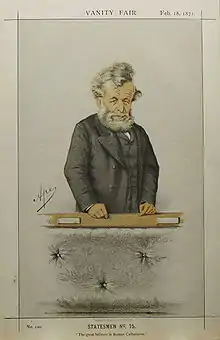George Hammond Whalley
George Hammond Whalley (22 January 1813 – 8 October 1878)[1] was a British lawyer and Liberal Party[2] politician.


Whalley as caricatured by Ape (Carlo Pellegrini) in Vanity Fair, February 1871
He was the eldest son of James Whalley, a merchant and banker from Gloucester, and a direct descendant of Edward Whalley, the regicide. George was educated at University College London, gaining a first class degree in Metaphysics and Rhetoric, and entered Gray's Inn in 1835, being called to the bar in 1839. He was an assistant tithe commissioner between 1836 and 1847, writing over 200 articles for the Justice of the Peace between 1838 and 1842.[3] In 1838 and 1839 he published a pair of treatises on the Tithe Acts, which were expanded, bound and published in 1848 as The Tithe Act and the Whole of the Tithe Amendment Acts.
In 1846 he married Anne Wakeford, with whom he had a son and two daughters. During the Great Famine in 1847 he established several fisheries on the Irish west coast. In 1852 he was made High Sheriff of Caernarvonshire,[4] a Deputy Lieutenant of Denbighshire,[5] and a captain in the Denbighshire Yeomanry.[6]
He was chairman of the Llanidloes & Newtown Railway, the first in Montgomeryshire, from its inception in 1852 and was the first chairman of the Mid Wales Railway in 1859.[7] He was also active in the Railway Benevolent Institution[8] and the National Temperance League.[9]
Parliamentary career
He unsuccessfully stood for Parliament at the 1852 general election in Montgomery,[2] and was returned to Parliament on his second attempt at a by-election in December 1852[10] for the City of Peterborough.[11] There were reports of irregularities in the election, which had been heavily influenced by Earl Fitzwilliam, and his election was voided on 8 June 1853.[1] A second by-election was held on 25 June 1853, when Whalley was re-elected.[12] Another election petition was lodged, and a Committee of the House of Commons was established in July 1853 to investigate the case.[13] The committee determined that he had not been legitimately elected, and reinstated his opponent, Thomas Hankey.[14] He was once again elected, however, in the 1859 general election.[15]
An Anglican, Whalley was persuaded to lead the parliamentary campaign against Roman Catholicism, taking over from the ailing Richard Spooner. His principal aim was to abolish the Maynooth Grant, claiming that Britain was paying for the creation of priests whose goal was to turn Britain into a "citadel of Popery". His three motions for the creation of a committee to consider repeal of the grant were all defeated in 1861, 1862, and 1863, and he experienced difficulty in getting his anti-Catholic speeches heard due to opposition from the numerous Irish MPs.[16]
In 1866 he claimed to have evidence that Vatican machinations had caused the defeat of British troops in New Zealand, that Cardinal Cullen, the Irish primate, intended to place a Stuart pretender on the throne of England, and that the Pope had taken control of the British artillery corps, the police, the telegraph office, and railway companies.[17] He was also a zealous supporter of Arthur Orton, the notorious Tichborne Claimant, and was eventually jailed by Lord Chief Justice Cockburn, who tried the case, for contempt of court.[18]
He died insolvent [19] in 1878, still in office; his son, George Hampden Whalley, later became another MP for Peterborough between 1880 and 1883.
References
- Leigh Rayment's Historical List of MPs – Constituencies beginning with "P" (part 1)
- Craig, F. W. S. (1989) [1977]. British parliamentary election results 1832–1885 (2nd ed.). Chichester: Parliamentary Research Services. p. 509. ISBN 0-900178-26-4.
- T. Nicholas, Annals and antiquities of the counties and county families of Wales p. 416 ISBN 0-8063-1314-5
- "No. 21298". The London Gazette. 5 March 1852. p. 698.
- "No. 21364". The London Gazette. 5 October 1852. p. 2615.
- "No. 21356". The London Gazette. 7 September 1852. p. 2414.
- Gasquoine, C. P.; The Story of the Cambrian – a biography of a railway; Woodall, Minshall, Thomas & Co, 1922
- The Times 22 March 1861
- The Times 1 May 1861
- "No. 21389". The London Gazette. 7 December 1852. p. 3576.
- Craig, pages 237–238
- "No. 21452". The London Gazette. 28 June 1853. p. 1818.
- Hansard, vol. 129 cols. 544-56. 21 July 1853
- Hansard, vol. 129 col. 1726, 15 August 1853
- "No. 22258". The London Gazette. 3 May 1859. p. 1813.
- F. H. Wallis, Popular anti-Catholicism in mid-Victorian Britain p. 122 ISBN 0-7734-9324-7
- W. Arnstein, Protestant vs. Catholic in mid-Victorian England p212 ISBN 978-0-8262-0354-0
- . Dictionary of National Biography. London: Smith, Elder & Co. 1885–1900.
- Manchester Guardian 14 November 1883
External links
- Hansard 1803–2005: contributions in Parliament by George Hammond Whalley
- Portraits of George Hammond Whalley at the National Portrait Gallery, London

| Parliament of the United Kingdom | ||
|---|---|---|
| Preceded by Richard Watson George Wentworth-FitzWilliam |
Member of Parliament for Peterborough 1852–1853 With: George Wentworth-FitzWilliam |
Succeeded by Thomson Hankey George Wentworth-FitzWilliam |
| Preceded by Thomson Hankey George Wentworth-FitzWilliam |
Member of Parliament for Peterborough 1859–1878 With: Thomson Hankey to 1868 William Wells 1868–1874 Thomson Hankey from 1874 |
Succeeded by John Wentworth-FitzWilliam Thomson Hankey |
| Honorary titles | ||
| Preceded by Martin Williams |
High Sheriff of Caernarvonshire 1852 |
Succeeded by Robert Vaughan Wynne Williams |